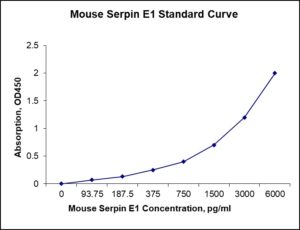Nori Mouse Serpin E1/PAI-1 ELISA Kit
$508.00 – $916.00
This ELISA kit is for quantification of Serpin E1 in mouse. This is a quick ELISA assay that reduces time to 50% compared to the conventional method, and the entire assay only takes 3 hours. This assay employs the quantitative sandwich enzyme immunoassay technique and uses biotin-streptavidin chemistry to improve the performance of the assays. An antibody specific for PAI1 has been pre-coated onto a microplate. Standards and samples are pipetted into the wells and any PAI1 present is bound by the immobilized antibody. After washing away any unbound substances, a detection antibody specific for PAI1 is added to the wells. Following wash to remove any unbound antibody reagent, a detection reagent is added. After intensive wash a substrate solution is added to the wells and color develops in proportion to the amount of PAI1 bound in the initial step. The color development is stopped, and the intensity of the color is measured.
Alternative names for serpin E1: Plasminogen activator inhibitor-1 (PAI-1), endothelial plasminogen activator inhibitor, serpine1, Mr1, Pai1, Planh1
This product is for Laboratory Research Use Only not for diagnostic and therapeutic purposes or any other purposes.
- Description
- How Elisa Works
- Product Citation (0)
- Reviews (0)
Description
Nori Mouse Serpin E1/PAI-1 ELISA Kit Summary
Alternative names for serpin E1: Plasminogen activator inhibitor-1 (PAI-1), endothelial plasminogen activator inhibitor, serpine1, Mr1, Pai1, Planh1
| Assay Type | Solid Phase Sandwich ELISA |
| Format | 96-well Microplate or 96-Well Strip Microplate |
| Method of Detection | Colorimetric |
| Number of Targets Detected | 1 |
| Target Antigen Accession Number | P22777 |
| Assay Length | 3 hours |
| Quantitative/Semiquantitative | Quantitative |
| Sample Type | Plasma, Serum, Cell Culture, Urine, Cell/Tissue Lysates, Synovial Fluid, BAL, |
| Recommended Sample Dilution (Plasma/Serum) | No dilution for sample <ULOQ; sufficient dilution for samples >ULOQ |
| Sensitivity | 18 pg/mL |
| Detection Range | 93.75-6000 pg/mL |
| Specificity | Mouse Serpin E1 |
| Cross-Reactivity | < 0.5% cross-reactivity observed with available related molecules, < 50% cross-species reactivity observed with species tested. |
| Interference | No significant interference observed with available related molecules |
| Storage/Stability | 4 ºC for up to 6 months |
| Usage | For Laboratory Research Use Only. Not for diagnostic or therapeutic use. |
| Additional Notes | The kit allows for use in multiple experiments. |
Standard Curve
Kit Components
1. Pre-coated 96-well Microplate
2. Biotinylated Detection Antibody
3. Streptavidin-HRP Conjugate
4. Lyophilized Standards
5. TMB One-Step Substrate
6. Stop Solution
7. 20 x PBS
8. Assay Buffer
Other Materials Required but not Provided:
1. Microplate Reader capable of measuring absorption at 450 nm
2. Log-log graph paper or computer and software for ELISA data analysis
3. Precision pipettes (1-1000 µl)
4. Multi-channel pipettes (300 µl)
5. Distilled or deionized water
Protocol Outline
1. Prepare all reagents, samples and standards as instructed in the datasheet.
2. Add 100 µl of Standard or samples to each well and incubate 1 h at RT.
3. Add 100 µl of Working Detection Antibody to each well and incubate 1 h at RT.
4. Add 100 µl of Working Streptavidin-HRP to each well and incubate 20 min at RT.
5. Add 100 µl of Substrate to each well and incubate 5-30 min at RT.
6. Add 50 µl of Stop Solution to each well and read at 450 nm immediately.
Background:
Serpin E1 also named Plasminogen activator inhibitor-1 (PAI-1) or endothelial plasminogen activator inhibitor, is a protein that in Mouses is encoded by the SERPINE1 gene. PAI-1 is a serine protease inhibitor (serpin) that functions as the principal inhibitor of tissue plasminogen activator (tPA) and urokinase (uPA), the activators of plasminogen and hence fibrinolysis (the physiological breakdown of blood clots). It is a serine protease inhibitor (serpin) protein (SERPINE1). The other PAI, plasminogen activator inhibitor-2 (PAI-2) is secreted by the placenta and only present in significant amounts during pregnancy. In addition, protease nexin acts as an inhibitor of tPA and urokinase. PAI-1, however, is the main inhibitor of the plasminogen activators. PAI-1 is mainly produced by the endothelium (cells lining blood vessels), but is also secreted by other tissue types, such as adipose tissue.
PAI-1 inhibits the serine proteases tPA and uPA/urokinase, and hence is an inhibitor of fibrinolysis, the physiological process that degrades blood clots (1). PAI-1 inhibits the activity of matrix metalloproteinases, which play a crucial role in invasion of malignant cells across the basal lamina (2). Congenital deficiency of PAI-1 has been reported; as fibrinolysis is not suppressed adequately, it leads to a hemorrhagic diathesis (a tendency to hemorrhage). PAI-1 is present in increased levels in various disease states (such as a number of forms of cancer), as well as in obesity and the metabolic syndrome. It has been linked to the increased occurrence of thrombosis in patients with these conditions. In inflammatory conditions in which fibrin is deposited in tissues, PAI-1 appears to play a significant role in the progression to fibrosis (pathological formation of connective tissue). Presumably, lower PAI levels would lead to less suppression of fibrinolysis and conversely a more rapid degradation of the fibrin. Angiotensin II increases synthesis of PAI-1, so it accelerates the development of atherosclerosis.
References
- Elokdah H, et al. (2004). J. Med. Chem. 47 (14): 3491–4.
- Boncela, J, et al. (2001). J. Biol. Chem. (United States) 276 (38): 35305–11.
Be the first to review “Nori Mouse Serpin E1/PAI-1 ELISA Kit”
You must be logged in to post a review.




























Reviews
There are no reviews yet.